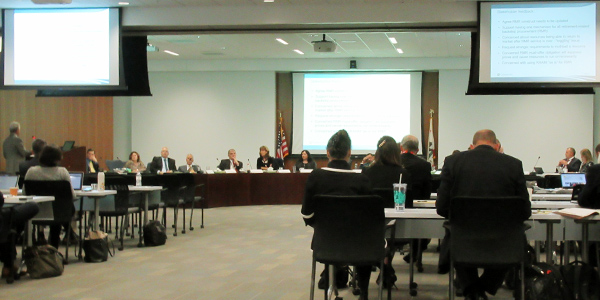By Hudson Sangree
FOLSOM, Calif. — CAISO’s Board of Governors on Wednesday unanimously approved a proposal meant to address concerns that the ISO’s market power mitigation rules disincentivize Pacific Northwest hydroelectric resources from participating in the Western Energy Imbalance Market.
The concerns arose shortly after Canada-based Powerex joined the EIM last April as the market’s first non-U.S. member. The company, responsible for marketing the ample surplus generation produced by BC Hydro, quickly determined that transmission constraints at the U.S.-Canada border were frequently triggering CAISO’s local market power mitigation (LMPM) processes in the EIM, which requires use of default energy bids (DEBs) to settle transactions. (See Troubled Waters for Powerex in EIM.)
Powerex found that the inflexibility of the formulas underpinning the DEBs left its market operations out of the money by forcing it to sell power into low-priced, oversupplied markets, when in fact it was attempting to buy on the cheap for later arbitrage. Other operators of the region’s fast-ramping hydroelectric resources noted the rules posed a similar risk for them.
“This issue is particularly acute in the Western Energy Imbalance Market because of the Northwest’s numerous hydro resources that have opportunity costs for energy sales because of their water limitations. Suppliers operating these resources may have disincentives to offer these needed flexible hydro resources to the EIM if they cannot reflect their costs,” CAISO Vice President Keith Casey wrote in his memo to the board regarding the proposal.
In response, the ISO proposed a set of market changes designed to prevent the LMPM process from resulting in the dispatch of resources at prices below their costs.
The plan, which still must be approved by FERC, would create a standard DEB for hydropower resources. The measure is needed, Casey wrote, because CAISO’s “market power mitigation process reduces a market participant’s submitted energy bid to a resource’s default energy bid, calculated by the ISO, in the event it detects market power. Default energy bids are intended to reflect a resource’s actual marginal costs of energy.”
The new option for DEBs is “specifically designed for hydro resources that better estimates these resources’ actual costs, which typically consist of opportunity costs reflecting their limited water availability,” Casey said in the memo.
Severin Borenstein, the newest board member appointed by California Gov. Gavin Newsom in January, indicated he wasn’t entirely comfortable with the proposal, but he voted for it nonetheless.
“I’m still trying to wrap my head around the economics of this,” said Borenstein, an MIT-trained economist and faculty director of the Energy Institute at the University of California, Berkeley’s Haas School of Business. “Cleary the hydro producers in the Northwest care about this” because they are getting value from the market and want it to operate in a way that’s more favorable to them, he said.
In other matters:
- The board unanimously elected David Olsen to another one-year term as its chair and named Angelina Galiteva as vice chair.
- Over objections from Pacific Gas and Electric and Southern California Edison, the board approved a plan to expand the EIM’s scope of authority on changes to real-time market rules when the primary driver of the changes is the EIM.
- The board approved CAISO’s 2018/19 transmission plan, with several major changes over last year’s plan. The plan, intended to ensure grid reliability, identified 13 new transmission projects at a projected cost of $644 million, all within PG&E’s service territory. It also recommended canceling six transmission projects in PG&E’s territory that planners concluded were no longer needed, eliminating $440 million to $550 million in future costs.
RMR/CPM Updates
The board approved a plan to improve CAISO’s reliability–must-run (RMR) and Capacity Procurement Mechanism (CPM) programs, which let the ISO procure energy and keep generators online that might otherwise be retired. Of particular concern are the state’s gas-fired plants that are essential for meeting peak demand but are under financial strain from the falling costs of solar and wind power.
The newly approved plan is intended to simplify and clarify the RMR process in accord with current market conditions and to compensate generators for keeping plants online.
Some stakeholders and board members expressed concerns that generators might propose retiring or mothballing plants to game the market. CAISO planners said they believed a new provision, requiring generators to submit an affidavit explaining their reasoning and intentions for retiring resources, would help mitigate those risks.



